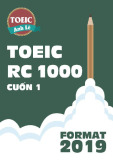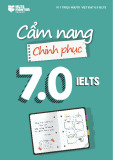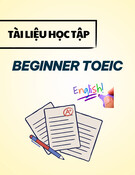
TNU Journal of Science and Technology
229(12): 236 - 243
http://jst.tnu.edu.vn 236 Email: jst@tnu.edu.vn
CHALLENGES AND SOLUTIONS FOR PRACTICING TOEIC THROUGH
TIKTOK VIDEOS: STUDENTS’ AND TEACHERS’ PERCEPTIONS
AT TERTIARY LEVEL
Duong Tran Thuy Trinh*, Nguyen Toan Bao Chau
Posts and Telecommunications Institute of Technology
ARTICLE INFO
ABSTRACT
Received:
04/6/2024
TikTok has recently been known as a popular social media platform
that appeals to a lot of teenagers due to its user-friendly and creative
content. Many teachers, therefore, take advantage of TikTok to provide
more learning opportunities for students. However, using TikTok as a
tool to study English poses different challenges. For that reason, this
article aims to explore the challenges and solutions of practicing
TOEIC through TikTok based on the teachers’ and learners’
perspectives. The authors conducted the research on teachers and
students at the Posts and Telecommunications Institution of Technology
at HCMC campus (PTIT). Two instruments employed in the study were
questionnaires (on 112 students) and interviews (with 4 random
students and 3 teachers). The findings from the research revealed the
students’ troubles in practicing TOEIC through TikTok regarding 3
main themes: technical, psychological and pedagogical issues. Based on
the given challenges, some solutions were also suggested by both
teachers and students to improve the effectiveness of practicing TOEIC
on TikTok.
Revised:
25/9/2024
Published:
25/9/2024
KEYWORDS
TOEIC
Tertiary level
Challenges
Teachers’ perceptions
Students’ perceptions
THÁCH THỨC VÀ GIẢI PHÁP KHI LUYỆN TẬP TOEIC QUA TIKTOK:
QUAN ĐIỂM CỦA SINH VIÊN VÀ GIẢNG VIÊN ĐẠI HỌC
Dương Trần Thuỷ Trinh*, Nguyễn Toàn Bảo Châu
Học viện Công nghệ Bưu chính Viễn thông, cơ sở TP.HCM
THÔNG TIN BÀI BÁO
TÓM TẮT
Ngày nhận bài:
04/6/2024
Gần đây, Tiktok, một nền tảng mạng xã hội nổi tiếng, đã thu hút được
giới trẻ với nội dung sáng tạo và thân thiện với người dùng. Vì vậy,
nhiều giáo viên đã tận dụng TikTok như một phương tiện học tập cho
người học. Tuy nhiên, việc học tiếng Anh qua TikTok có thể gặp phải
nhiều trở ngại. Vì lý do đó, bài nghiên cứu này nhằm mục đích tìm hiểu
những thách thức và giải pháp khi luyện tập TOEIC qua TikTok, thông
qua góc nhìn của giảng viên và sinh viên. Nhóm tác giả đã tiến hành
nghiên cứu với giảng viên và sinh viên tại Học viện Công nghệ Bưu
chính Viễn thông, cơ sở TP.HCM (PTIT). Hai công cụ nghiên cứu được
sử dụng bao gồm khảo sát (trên 112 sinh viên) và phỏng vấn (với 4 sinh
viên lựa chọn ngẫu nhiên và 3 giảng viên). Kết quả từ nghiên cứu cho
thấy sinh viên gặp 3 vấn đề chính: các khía cạnh kỹ thuật, tâm lý và
giáo dục khi luyện tập TOEIC qua TikTok. Với những thách thức được
nêu, giảng viên và sinh viên đã đưa ra những đề xuất để nâng cao hiệu
quả của việc luyện tập TOEIC qua TikTok.
Ngày hoàn thiện:
25/9/2024
Ngày đăng:
25/9/2024
TỪ KHÓA
TOEIC
Trình độ đại học
Thách thức
Quan điểm của giảng viên
Quan điểm của sinh viên
DOI: https://doi.org/10.34238/tnu-jst.10540
* Corresponding author. Email: thuytrinh@ptithcm.edu.vn

TNU Journal of Science and Technology
229(12): 236 - 243
http://jst.tnu.edu.vn 237 Email: jst@tnu.edu.vn
1. Introduction
In this day and age, the advancement of new social media platforms not only creates more
tools for entertainment and communication, but also provides people with further pedagogical
opportunities. Of all the popular platforms, TikTok is currently emerging as the most appealing
app due to its engaging contents, user-friendly interface and viral trends. People can easily find
information on a wide range of topics including entertainment, lifestyle, technology, business,
art, and social issues, among others. These videos are designed in short format with attractive
features, so they can easily captivate people’s interest and attention in today’s fast-paced world.
In teaching and learning, the use of TikTok can promote learners’ motivation, create an
attractive learning environment, develop creativity and enhance learners’ confidence. Students
who have learned through TikTok feel more motivated and demonstrate greater commitment to
the content than those who did not [1]. Besides, with various engaging contents and appealing
platforms, TikTok can easily capture learners’ attention in the learning process. It also provides
some interactive features such as likes, shares and comments which allow the users to create an
interactive learning community. On this platform, learners are not only able to watch videos
created by native speakers, but also create their own videos to express their own ideas or show
their understanding of a particular topic [2]. The process of practicing English by making videos
can obviously foster the learners’ confidence in language learning.
However, that is not to say that the use of TikTok in teaching and learning poses no risks or
obstacles. Regarding technical problems, learners may find it difficult to learn on TikTok because
of the small-screen size, poor Internet connection and fast speed of TikTok videos. It can be
observed that TikTok videos are typically designed to suit the small size of mobile devices. This
may cause trouble to the users because they have to struggle with the small fonts of the input data
on that platform [3]. Along with that, due to the limited length of TikTok videos, the information
is usually delivered quickly and lacks detail [4]. Consequently, language learners may find it hard
to follow the instructions and acquire the knowledge effectively. Moreover, through TikTok, the
complex information may become oversimplified, which prevents learners from having deep
understanding about particular content. In other words, TikTok can be seen as inadequate for
effectively conveying complex information. Another technical problem that learners encounter
when learning on TikTok is unstable Internet connection. It is suggested that Internet connection
is one of the disadvantages of learning online [5]. With poor Internet connection, students’
learning process can be disrupted and their motivation in self study can also be diminished.
Concerning psychological problems, learners have to face challenges such as getting
distracted by other entertaining content or losing focus due to disruptive sound effects. They may
lose concentration on learning on TikTok due to being attracted to other interesting videos [6].
TikTok’s platform was originally designed for entertainment purposes, so learners would be
likely to spend more time scrolling through TikTok rather than paying attention to their video
lessons. This distraction can lead to a delay in learning or energy depletion when it comes to
study time. Besides, in order to make interesting videos on TikTok, the creators can utilize sound
effects to engage learners in the lessons. However, the overuse of these effects may cause
confusion and negatively affect the learning process.
In addition to the technical and psychological issues mentioned above, English learners also
have to confront other pedagogical issues. First of all, they may have limited opportunities for
pedagogical interactions of a meaningful educational context. Learning on TikTok videos means
learners miss the atmosphere of traditional teaching and learning process [7]. They will obviously
lack meaningful feedback from teachers and peers, and struggle to receive immediate
clarification or assistance from content creators when encountering difficulties. Second, the
brevity and rapid pace of TikTok videos can hinder independent thinking among learners. Due to
the short-form characteristic of TikTok’s platform, the video lessons on TikTok are usually very

TNU Journal of Science and Technology
229(12): 236 - 243
http://jst.tnu.edu.vn 238 Email: jst@tnu.edu.vn
short and fast-paced. Learners are accustomed to receiving direct answers for the questions
without having sufficient time to engage in critical thinking and reflection. For a long period of
time, this reliance on quick answers can lead to a decrease in motivation and a tendency to avoid
tackling challenging questions independently. Third, learners can hardly familiarize themselves
with the time constraints of an actual test when they study on TikTok. For example, in a real
TOEIC test, the test takers are required to answer 200 questions in 120 minutes. That is truly a
significant time pressure. In order to achieve high scores, apart from equipping themselves with
knowledge of language skills, learners should also obtain effective time management skills.
However, learning on TikTok may diminish this ability as its platform only allows learners to
practice specific questions of the test at a particular time. The final obstacle to mention when
learning on TikTok is the possibility of lacking accuracy. Like other kinds of social media, every
user can freely create and upload their own videos showing their understanding of particular
topics, but not many of them are professional instructors or teachers. There will be a wide
variation in terms of quality and accuracy of the videos and learners may have trouble choosing
reliable channels for their language learning on TikTok. Therefore, learners should be careful
with public content and should ensure the credibility and reliability of the materials when
learning on social media [8].
Overall, the review of previous studies has shown that, despite several benefits, using TikTok
as an instructional tool in teaching and learning should be carefully considered due to its potential
challenges. Therefore, this study aims to explore the difficulties of practicing for the TOEIC test
(a popular standardized English assessment for students at the tertiary level) on this kind of social
media platform. Based on the acknowledged problems, some solutions are given to enhance the
effectiveness of the learning process and improve the TOEIC scores. In other words, this study
sets out to answer the following research questions:
1. What are the challenges of practicing TOEIC through TikTok videos?
2. What are solutions to improve the effectiveness of practicing TOEIC through TikTok videos?
2. Methods
In this study, quantitative and qualitative methods were employed to explore the challenges of
practicing TOEIC through TikTok. Firstly, a questionnaire was used to collect students’
responses on their perceived challenges of practicing TOEIC through TikTok videos. After that, a
semi-structured interview was conducted to triangulate with the results from the questionnaire,
and further investigate the teachers and students’ suggested solutions to improve the effectiveness
of practicing TOEIC through TikTok videos.
The questionnaires were distributed to 164 non-English majored students at PTIT through
Google Forms but only 112 answers were collected from the respondents. The responses from
questionnaires provided information about the difficulties faced by learners when practicing the
TOEIC test on TikTok. Meanwhile, the interviews conducted with 3 English lecturers and 4
randomly chosen students aim to discover in-depth information about the challenges and
solutions of practicing the TOEIC test on TikTok. During the interview, the researchers got
permission to record the responses. The participants were given chances to freely express their
thoughts and provide suggestions for the use of TikTok as a pedagogical tool.
The quantitative data collected from the questionnaire were analyzed by the use of descriptive
method to explore the general tendencies of the phenomenon. At the same time, the data from the
interview were collected and transcribed for analysis.
3. Findings and discussion
This section presents the findings of the research. Based on the review of literature, the
responses were coded and categorized in three themes, namely physical, psychological, and
pedagogical challenges.

TNU Journal of Science and Technology
229(12): 236 - 243
http://jst.tnu.edu.vn 239 Email: jst@tnu.edu.vn
3.1. Students’ perceptions of practicing TOEIC through TikTok videos
3.1.1. Physical challenges
Students’ perceptions towards physical challenges when learning for the TOEIC test through
TikTok are demonstrated in Table 1.
Table 1. Students’ perceptions of physical challenges
Strongly
agree
Agree
Neutral
Disagree
Strongly
disagree
I don’t feel comfortable because the video sizes on
Tiktok is only suitable for studying on smartphones
17.5%
21.4%
34.8%
25.2%
10.7%
I find it inconvenient because of internet connection
errors when studying on Tiktok
13.4%
27.7%
19.6%
20.5%
18.8%
I find it difficult studying efficiently because the
speed of the videos on Tiktok is too short and too fast
17%
22.3%
25.9%
21.4%
13.4%
Regarding the first statement of the questionnaire “I do not feel comfortable because the video
size on Tiktok is suitable only for studying on smartphones”, the percentage of participants who
agreed (39.3%) is slightly higher than those who disagreed (35.9%). This result is consistent with
Shudong and Higgins’s finding [3] in indicating that TikTok video size can pose a problem for
learners who practice the TOEIC test through it.
Similarly, there were a greater number of students having a negative perception toward the
speed of TikTok videos. In particular, the percentage of the surveyed students showing their
agreement with the statement “I find it difficult studying efficiently because the speed of the
videos on Tiktok is too short and too fast” was higher, at 39.3%, compared with 34.8% of the
students who disagreed or totally disagreed. This corroboration with Afreliyanna’s conclusion [4]
reinforces the fact that the speed of the Tiktok videos can hinder the students from practicing the
TOEIC test effectively.
On the other hand, the second statement of the questionnaire “I find it inconvenient because of
internet connection errors when practicing with Tiktok” records a more balanced view from the
students (41.1% agreed and 39.3% disagreed). Although there was no significant difference
between those who agreed and disagreed with this item, the proportion of students who felt
uncomfortable with the internet connection errors was the highest in comparison with the other
physical challenges. This aligns with the discussion of Hoang et. al [5] on internet connection as
the disadvantage of learning online.
3.1.2. Psychological challenges
The psychological challenges addressed in this study include the distractions of studying with
TikTok videos and the limitation of interaction with TikTok. Table 2 demonstrates the students’
perceptions towards these psychological challenges.
Table 2. Students’ perceptions of psychological challenges
Strongly
agree
Agree
Neutral
Disagree
Strongly
disagree
I am easily attracted by other entertainment
videos on Tiktok
47.3%
30.4%
12.5%
6.3%
3.6%
I am distracted by sound effects when studying
with Tiktok videos
19.6%
26.8%
23.2
18.8%
11.6%
I find Tiktok videos unsuitable for delivering
information at a complex level
21%
22%
25%
20%
12%
I don’t have opportunities to interact with others
when studying on Tiktok
32.1%
16.1%
20.5%
14.3%
17%

TNU Journal of Science and Technology
229(12): 236 - 243
http://jst.tnu.edu.vn 240 Email: jst@tnu.edu.vn
The majority of the students reported that they are easily distracted by other entertaining videos
on the platform (87%), while more than half of the students are distracted by sound effects from
TikTok videos (52%). As stated by Hongsa et al. [6], this distraction leads to procrastination in
learning or dissipates their energy, affecting their concentration on academic tasks.
Interaction is considered as one major factor in the students’ learning, however, the students
surveyed did not experience good interaction when learning on TikTok videos, with 54% of the
students agreeing with the statement “I do not have the chance to interact with others when
studying on Tiktok”. This lack of interaction becomes one of the critical barriers when students
are studying online [9].
In contrast, the students expressed a more neutral view on the delivering capability of TikTok
videos. While 43% of the students agreed with the statement that TikTok is not capable of
delivering complex information, 44% of the students disagreed or strongly disagreed with the
statement. In this regard, the factor to the success of studying through Tiktok videos might fall
back on the design of the videos [10].
3.1.3. Pedagogical challenges
The students were asked to give their perceptions about the pedagogical challenges when
studying on Tiktok, including their perceptions on time issues, the content of Tiktok videos and
the feedback students receive when studying on Tiktok (Table 3).
Table 3. Students’ perceptions on pedagogical challenges
Strongly
agree
Agree
Neutral
Disagree
Strongly
disagree
I don’t have enough time to comprehend and
answer the practice questions on Tiktok
13.5%
27.7%
21.4%
20.5%
17%
I’m not sure about the accuracy of the practice
questions on Tiktok
20.5%
30.4%
25%
16.1%
8%
I can’t receive feedbacks on my answers when
studying for TOEIC on Tiktok
22.5%
26.1%
27%
17.1%
7.2%
I’m dependent on answers on Tiktok instead of
spending time thinking about my own answers
29.5%
20.5%
26.8%
10.7%
12.5%
I can’t familiarize myself with time pressure when
studying on Tiktok
37.5%
28.6%
17%
8.9%
8%
The practice questions on Tiktok can’t cover all
question types on the TOEIC test
28.6%
28.6%
24.1%
11.6%
7.1%
In respect to time issues, students held negative perceptions, with the majority of the students
are (74 out of 112 students) concerned about the time limits when doing the exercise on Tiktok
compared with the real test. Aligning with the findings from Lin et al. [7], the short-form feature
of TikTok videos affects the students’ comprehension of the questions. Despite the disagreement
from 16.9% of the students, 66.1% agreed that it is more difficult for them to familiarize
themselves with the real time pressure of the TOEIC test. Part of the reason is that students must
answer 200 questions in 120 minutes, but the size of the TikTok videos allows them to answer
specific questions in a duration of time. This diminishes their ability to manage their time
effectively when having to deal with a bigger set of questions from the real TOEIC test.
Moreover, the nature of the TikTok videos is giving fixed contents; therefore, students only
know whether they have chosen the right or wrong answers, but the videos cannot give them
reflections on why their answers are incorrect. Even though this provides them with prompt
answers, the videos do not have washback values. Brown [11] stated that the challenges of
classroom tests is how the students’ incorrect responses can provide them an insight into their
further study process. The weakness of TikTok videos is its lack of prompt feedback. While there
is a comment section where students can ask questions and receive relevant answers, it takes a
longer time for the students to receive an answer.



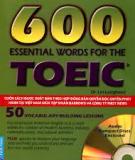
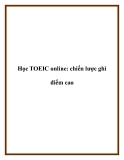
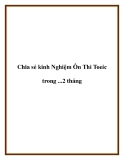





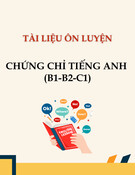

![Tài liệu luyện thi TOEIC cấp tốc trong 10 ngày [chuẩn nhất]](https://cdn.tailieu.vn/images/document/thumbnail/2025/20251029/kimphuong1001/135x160/99661761725822.jpg)
![Tài liệu Phá đảo TOEIC 900+ từ mất gốc trong 30 ngày [Mới nhất]](https://cdn.tailieu.vn/images/document/thumbnail/2025/20251029/kimphuong1001/135x160/2101761720956.jpg)
